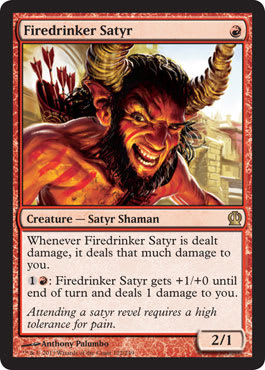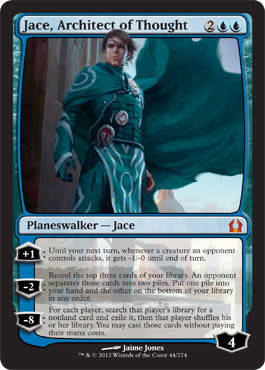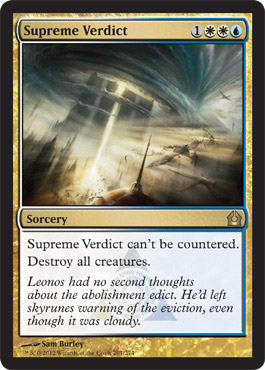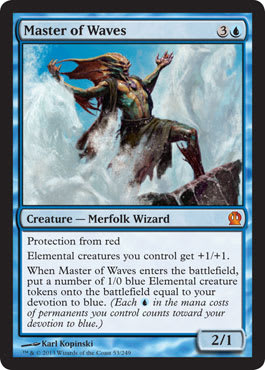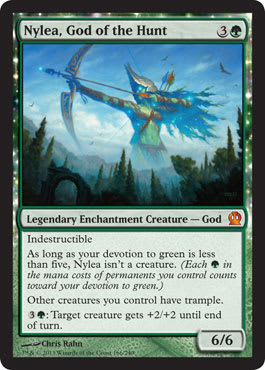I decided to change things up at Pro Tour Theros, and while I’m glad I did, my results were definitely mixed—due to unforeseen events. In recent years, I’ve leaned heavily toward aggressive decks for the Constructed portion of Pro Tours while forcing specific colors for the Draft portion. While I’ve had solid reasons for doing so, I think I’ve been holding myself back. This time, I decided to take the gloves off.
The reason I leaned toward aggressive decks was to make my play decisions easier. In the past, I wouldn’t have taken such a thing into consideration because I have always had supreme confidence in my ability to play as well as anyone in the world. In recent years, I’ve begun to reconsider that attitude for practical reasons. First, due to other parts of my life getting in the way, I spend much less time prepping for Pro Tours. Second, now that Pro Tours are two formats instead of one, I am forced to split that reduced prep time, making my Constructed prep time even briefer.
Playing aggressive decks help in multiple ways. First, I don’t have to know the metagame all that well. My goal is to try to kill my opponent before his or her deck really gets going, whatever he or she happens to be playing. Second, shorter games make for fewer decision points, which I figured would help me compensate for my lack of prep time. Third, the decisions are usually simpler: Do I burn the opponent’s creature or save it for his or her face? Do I play all of my creatures or hold some back? Do I keep a one-land hand? Those were usually the toughest questions that came up.
In Draft, I compensated for lack of prep time by picking one or two archetypes and just trying to master and force those rather than prepare to play whatever would be passed to me. This strategy was better-suited and more effective for drafting some sets than others.
As I prepped for Pro Tour Theros, I decided on a major change to my approach. With my old approach, I usually either just missed Day 2 or barely made Day 2, but I certainly wasn’t finishing in the money. Given my lack of prep time, the results I was getting were respectable, but I’m way past worrying about whether my results are respectable. I attend Pro Tours for glory, money, and playing against the best competition at the highest level. It was certainly worth risking being crushed on Day 1 in the cause of trying to improve my merely “respectable” results.
There were two big problems to my approach to Constructed. First, I wasn’t always playing a deck that was well-placed for the metagame. Second, by trying to shorten games and reduce the number of decisions that needed to be made, I was taking away one of my biggest advantages: the fact that I’m a really good Magic player.
As I tested for Pro Tour Theros, one of my best decks was a W/U control deck featuring powerful cards such as Supreme Verdict, Jace, Architect of Thought, Aetherling, and Sphinx's Revelation. As Christian Calcano pointed out to me after our feature match at the 5K in Worcester, this format has many similarities to Return to Ravnica Block Constructed. Back when I was testing for Block, W/U was my favorite deck—it just really needed a game-ender, and I failed to try out Aetherling, so I didn’t play it. As I tested this time, I felt that, in most matchups, how well I did with W/U depended largely on how well I played. If I played well, every matchup seemed to range from pretty good to great. There appeared to be two exceptions: Esper and, ironically, mono-red aggro. With my three main-decked Aetherlings, I definitely had game against Esper before sideboarding, and I determined that the proper sideboard plan would even make the post-boarding matchup quite tolerable. This left mono-red as the one near-impossible matchup.
My decision to play W/U control primarily came down to three considerations.
I wanted to play a deck that rewarded me for excellent game play. By playing a longer-game control deck, I gave myself the opportunity to win almost any matchup as long as I made good enough play decisions. Given my experience and success as a player, this seemed to be a way to increase my win percentage in Constructed.
The metagame leading up to the event suggested W/U control would be well-placed. As I carefully examined the results of Standard 5Ks before the Pro Tour, I liked the metagame trend. Initially, W/U and, to a lesser extent, Esper seemed to be the top decks. Partially as a result, one early 5K (in Worcester) was won by mono-red, beating W/U in the finals. The next weekend, most top players seemed to abandon blue-based control decks (perhaps in fear of red aggression), and instead, the field was dominated by midrange creature decks. In a simplistic rock–paper–scissors view of Constructed Magic, control beats midrange, aggro beats control, and midrange beats aggro. While there are an incredible number of exceptions to this rule, the rule seemed to fit this particular metagame pretty well. Based on the last Pro Tour, the 5Ks the weekend before a Pro Tour are strong predictors of the field at the Pro Tour. If the field was going to be largely midrange creature decks and nonblue control, I wanted to be playing with Supreme Verdict and Sphinx's Revelation.
With my limited prep time, W/U control was among the few decks that I had a good feel for. The choice was to play W/U, play an aggressive deck, or play a deck I didn’t really have a feel for. It helped that I played W/U at the Worcester 5K. I dropped out at 4–3–1, but I felt my record didn’t tell the whole story. First of all, I was 4–0 against midrange creature decks and nonblue control. My losses came against Boros aggro and to two Esper decks. My draw was, fittingly, against another W/U deck. I was happy with my deck at Worcester, but I felt I needed a much better sideboard, and I needed to learn how to play against other blue control decks better. All three of my matches against blue control at Worcester felt close enough that a better sideboard plan and some tighter play could make a huge difference.
This is the deck I played at Pro Tour Theros:
"W/U Control"
- Creatures (3)
- 3 Aetherling
- Planeswalkers (5)
- 1 Elspeth, Sun's Champion
- 4 Jace, Architect of Thought
- Spells (24)
- 4 Azorius Charm
- 4 Essence Scatter
- 4 Sphinx's Revelation
- 4 Syncopate
- 4 Supreme Verdict
- 4 Detention Sphere
- Lands (28)
- 9 Island
- 9 Plains
- 2 Mutavault
- 4 Azorius Guildgate
- 4 Hallowed Fountain
- Sideboard (15)
- 4 Soldier of the Pantheon
- 3 Precinct Captain
- 4 Negate
- 2 Last Breath
- 2 Celestial Flare
Most of my reasoning for playing W/U at the Pro Tour was vindicated at the event. In ten rounds of Standard, I didn’t play against a single mono-red deck, and I played against multiple nonblue control decks, multiple midrange creature decks, and two Esper decks. I went 1–1 against Esper, winning both my Game 1s, thanks largely to my experience against Esper in Worcester and winning one of my games after sideboarding largely to my new plan of bringing in cheap creatures. I wasn’t able to win my other Esper match after boarding, in part because, even though he didn’t have removal for the two cheap creatures in my opening hand in one of the games, he Thoughtseized both of them on turn two after I played a Guildgate on my first turn.
I went 5–4–1 in Standard at the Pro Tour, which was disappointing due to how well I knew the deck and how well it was placed for the metagame. Unfortunately, I ran into two problems. The first was I played against mono-blue twice (going 0–1–1), which was a deck I was completely unfamiliar with, which hurt me much more with this deck than it would have with an aggro deck. Not understanding the deck’s game plan or knowing the deck’s contents made it difficult to know what to counter, when to tap out, when to play Verdict, whether to play around permission, and so on. The matchup was favorable enough that I might have been able to overcome these factors if I played at my highest level. Alas, that wasn’t to be, due to the second problem I ran into.
I flew to London and then Dublin the day before the event. I missed multiple connecting flights in London and didn’t make it to my hotel in Dublin until the evening before the event, with my luggage arriving much later. Unable to sleep on the plane, I was exhausted and jetlagged, and worse yet, I was sick with sore throat, congestion, and a dull ache in my head. Needless to say, this was not an ideal state of affairs for me to play a complex deck and complex matchups at the highest possible level. I would go from making a series of complex and precise plays to win a seemingly impossible game to later targeting my opponent’s Jace with a Detention Sphere while having my own Jace out that I hadn’t even used yet, which was then removed by my own Sphere. I’m mildly surprised I did as well as I did all things considered.
I also took a different approach to Draft. I drafted Theros 8–4s on Magic Online a half-dozen times before the event. I tried to find a color combination to lock into, but since I failed to make it past Round 2 in any of the Drafts I did, I was unable to find a compelling strategy to lock into. So instead, I adopted a strategy somewhat like my new approach to Constructed. I would read my seat and draft what was coming to me. Draft has long been one of my best formats whether forcing colors or reading the Draft. Lacking mastery of any archetype, I fell back on my basic drafting skills that have carried me so far in the past.
At my first table, I opened a Sea God's Revenge and took it. Other good blue cards followed, and I took them while waiting to see what other color I would pick up to complement it. I ended up U/B. The black cards I picked up were largely unspectacular, but they went well with my blue. On Day 2, I opened Nylea, God of the Hunt, and I turned out to be in a good seat for B/G. I think I read my seat better on Day 2 (perhaps in part because my health was improving), and I went 3–0 after going 1–1–1 in my first Draft. There is also the fact that, in the one match I lost, my opponent first killed me on turn five and then killed me on turn four. In Game 2, he played a turn-two Battlewise Hoplite and a turn-three Fabled Hero, and when I didn’t block on turn four (I was tapped out and at 18 life), he played both Dauntless Onslaught and Coordinated Assault, hitting me for 22! Considered he was playing three colors, it was no surprise when he informed these were his two best draws of the day (this was the third round with that deck).
The fact that I did as well with W/U at the Pro Tour as I did at the 5K in Worcester and that I did even better at the Pro Tour in Draft than I did on Magic Online, all despite my illness, suggests that I had the right idea with my paradigm shift. I finished in the top hundred, with a record of 9–5–2. It was my best Pro Tour finish since they switched to two formats. One more win would have landed me in the money. Given the number of games that fell by the wayside as I struggled to concentrate through the haze in my head, I’m encouraged about using a similar paradigm at future Pro Tours. Despite not winning any money, I found the event really exciting, and it reinvigorated my enthusiasm for preparing for and attending future Pro Tours. Apparently, I’ve been letting fear of being overwhelmed with decisions get in the way of my success in both formats. Lesson learned. Now, if I could only afford the time and money to go to events a week in advance to rest up and prepare!
For those of you wondering where my articles have been for a couple weeks, I was prepping for Pro Tour Theros, of course, but I’ve also been continuing work on my new deck-building game Star Realms. The Kickstarter campaign for Star Realms is now in full swing.
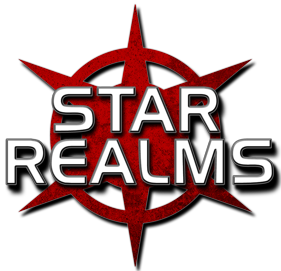
I hope you'll at least stop by, check out our video, and see what reward tiers we're offering.













